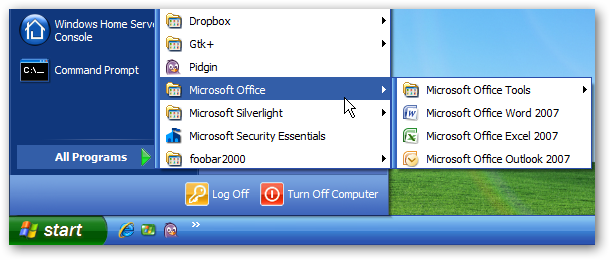Where Is The Startup Programs Folder In Windows Xp
TipWhen the Start menu is open, you can open the All Programs menu in a number of ways: by clicking the All Programs menu, by pointing to it and keeping the mouse still for a moment, or by pressing the P and then the right-arrow keys on your keyboard.Speaking of keyboard fanaticism: Once the programs list is open, you can also choose anything in it without involving the mouse. Just type the first letter of a program’s name—or press the up and down arrow keys—to highlight the name of the program you want. Then press Enter to seal the deal.Clearly, the graphic designers were on vacation the day Microsoft came up with this one. The All Programs menu appears superimposed on the regular Start menu, adding a third column in a second layer—not the most elegant visual solution, to be sure, but at least easy to find.
NOSTALGIA CORNERRestoring the Single-Column Programs ListIf you have a lot of programs, the All Programs menu may itself consume multiple columns on your screen. If this columns-on-columns effect makes you a bit dizzy, just replace it with the simple, one-column, scrolling Programs menu of Windows gone by.To do so, right-click the Start button, then choose Properties from the submenu. Next, click the Customize button, click the Advanced tab, and scroll down the list of options until you see Scroll Programs. Turn on the checkbox and then click OK twice.Now your programs list may still be too tall for the screen. But you can scroll the list by pointing to the tiny black triangle arrow (at the top or bottom of the menu) without clicking.
And of course, you can always select items in the list from the keyboard.In fact, although few PC users suspect it, what you put into the Startup folder doesn’t have to be an application. It can just as well be a certain document you consult every day. It can even be a folder or disk icon whose window you’d like to find open and waiting each time you turn on the PC. (The My Documents folder is a natural example.). Figure 1-7. The Start →All Programs menu may list the actual application (such as Microsoft Word) that you can click to launch the program. But it may also list a program group, a submenu that lists everything in a particular application folder. Some software programs install a folder on the All Programs menu, like the Office Tools folder shown here, that contains commands for launching the software, uninstalling the software, running specific utilities, opening the help files, and so on.Of course, you may be interested in the Startup folder for a different reason: to stop some program from launching itself.
This is a particularly common syndrome if somebody else set up your PC. Some program seems to launch itself, unbidden, every time you turn the machine on.Click the Start button.


Disabling Startup Programs in Windows 7, Vista, or XP. For some programs, it’s smart to have them start with Windows, such as anti-virus and firewall software. However, for most programs, starting them at boot-up just wastes resources and extends startup time. Easily Add Programs to Windows 7 Startup. This article shows you an easy way to add programs to the Windows 7 startup folder for. How to Change Windows Startup Programs. To open the Startup menu in Windows 7. How to Remove Startup Programs by Mitch Tulloch. When I try these two paths on my main Windows XP machine, my Startup folder.
Point to All Programs. Right-click Startup and choose Open from the shortcut menu.The Startup window opens, revealing whatever is inside.To delete an icon from this folder, just right-click it, choose Delete from the shortcut menu, and answer Yes to send the icon to the Recycle Bin. Close all the windows you’ve opened and enjoy your newfound freedom from self-launching software. The deed is done.To add a new icon to the Startup folder, on the other hand, read on.Navigate to the disk, folder, application, or document icon you want to add to the Startup folder.Doing so requires familiarity with one of two folder-navigation schemes: My Computer or Windows Explorer. Both are described in the next.Using the right mouse button, drag the icon directly into the Startup window, as shown in.When you release the button, a shortcut menu appears.Choose Create Shortcuts Here from the shortcut menu.Close all the windows you’ve opened. From now on, each time you turn on or restart your computer, the program, file, disk, or folder you dragged will open by itself. TipTo find out what something is—something in your Start menu, All Programs menu, or indeed anywhere on your desktop—point to it with your cursor without clicking.

Win Xp Add Program To Startup Menu
A small yellow tooltip appears, containing a text description. (If the tooltip doesn’t appear, it might be that the window you’re pointing to isn’t the active window on your desktop. Click the window and then try again.)With Safari, you learn the way you learn best.
Windows 7 Startup Folder
Get unlimited access to videos, live online training,learning paths, books, interactive tutorials, and more.
On Windows XP I use 18 programs. In startup it makes 2-3 minutes to load all of them.Anti virus, translator, unlocker, file indexer, download manager, instant messenger etc.I need all of them and they are on Windows system tray waiting for me to use.So I can't remove one of them, because I use them frequently.